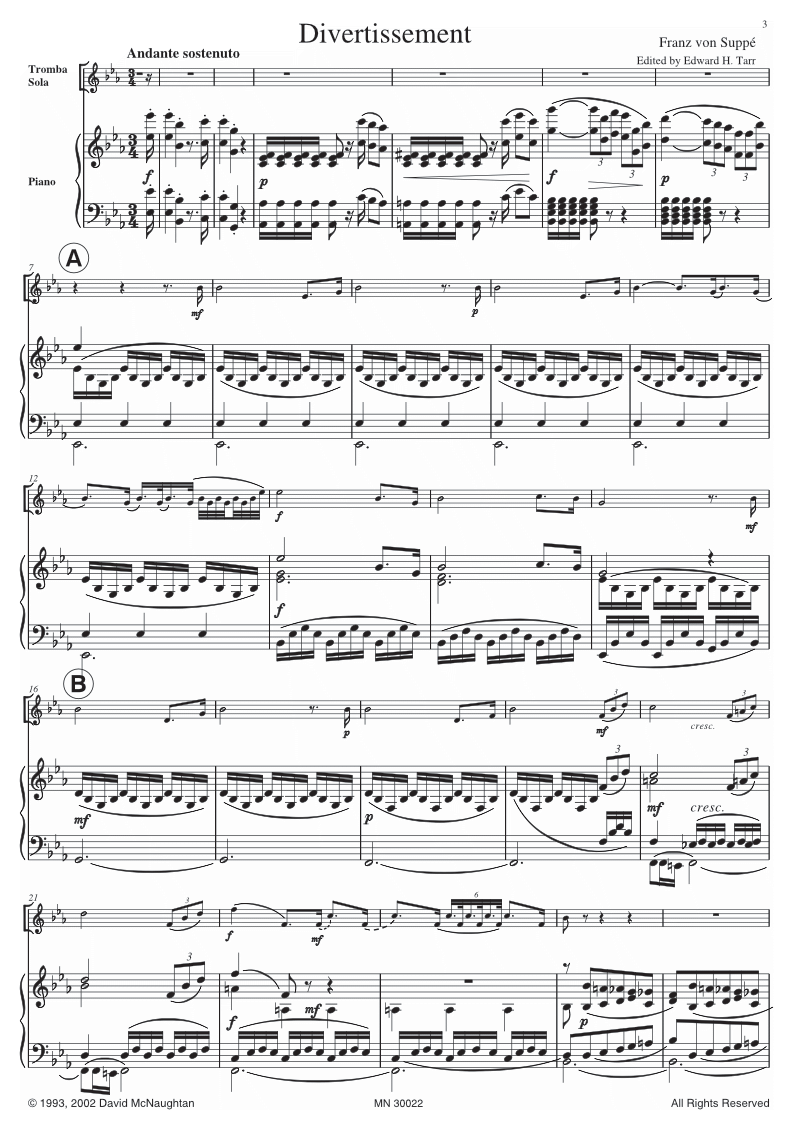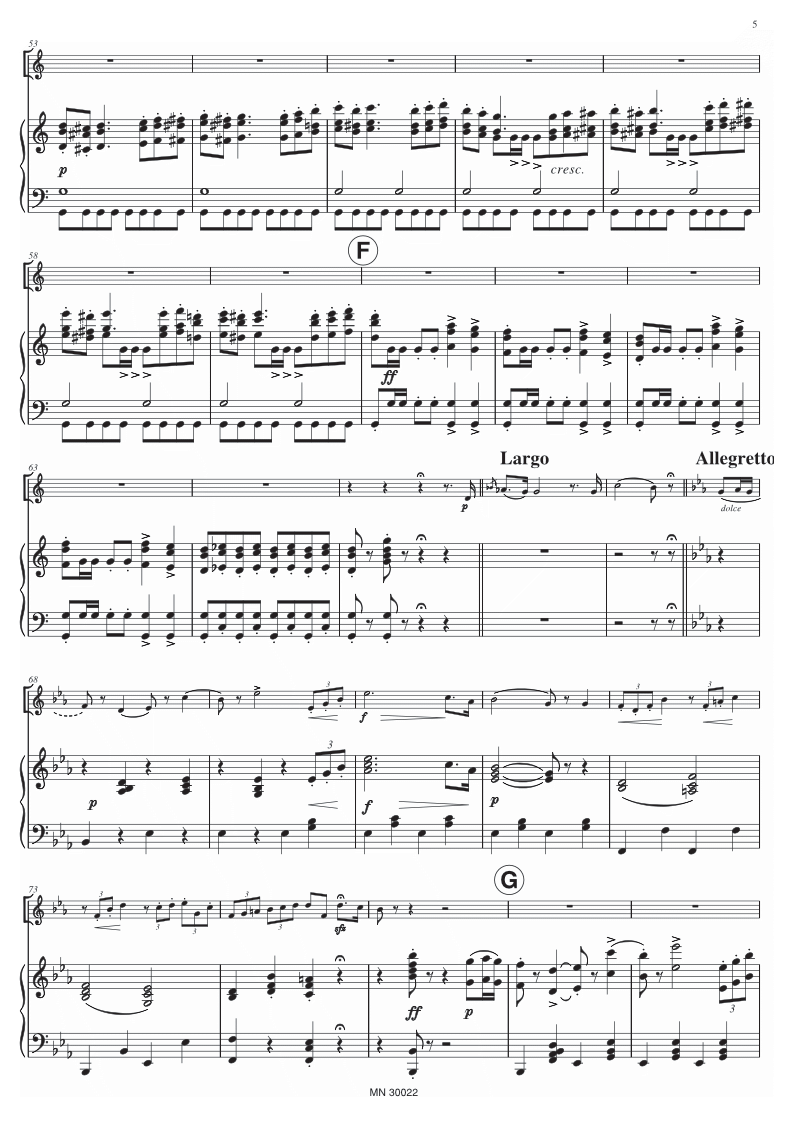
Suppé Divertissement
Instrumentation: Trumpet, PianoDifficulty (I-VI): IV
Parts for:
Trumpet in F and Bb, Piano
Series: Edward Tarr Brass
Editor: Edward H. Tarr
The Composer’s Life and Works
The undying fame of Franz von Suppé (1819-1895) is founded upon his operettas and some overtures which are still frequently performed today, such as Poet and Peasant (to a comedy with songs, 1846) or Light Cavalry (to an operetta, 1866). The present Divertissement for Obligato Trumpet is a fortunate by-product of his pen.
Francesco Ezechiele Ermenegildo Cavaliere Suppé Demelli was born in Spalato, Dalmatia (present-day Split). His ancestors, who originally came from Belgium, obtained citizenship in Cremona; his grandfather and father were regional commissary and regional captain, respectively, of Dalmatia, with their office in Spalato. In 1820 the family moved to Zara, where the young Francesco was encouraged in his musical development by both the local bandmaster and the cathedral organist, although his father would have preferred seeing his son interested in other pursuits. On his father’s wish, Francesco began law study at the University of Padua, however taking every occasion to visit Milan, where he heard the latest operas by Rossini, Donizetti (with whom he was distantly related and who offered him helpful advice later in life), and the young Verdi, even making the acquaintance of these composers personally.
After his father’s death in 1835, his mother returned with him to her native city of Vienna, where he spent the rest of his life, even though he was never able to speak German without an accent. Here the die was cast: he broke off medical studies and devoted himself entirely to music. He received thorough training for his future profession as a theatre conductor from Simon Sechter (1788-1867), the most famous theory teacher in the city, who also numbered Vieuxtemps and Bruckner among his pupils, and from Ignaz Ritter von Seyfried (1776-1841), himself a composer and conductor of opera. Small wonder that young Franz von Suppé, as he was henceforth called, was destined for the pit.
In 1840 Suppé landed his first job, albeit one which was strictly voluntary, i.e. unpaid for a time, as 3rd conductor at the Theatre an der Josefstadt, an establishment which belonged to its director, Franz Pokorny (Frantisek Xaver Jan Pokorny), 1797-1850). Soon he was also conducting in Pokomy’s other theatres: in the winter in Pressburg, in the spring in Vienna, and in the summer in Baden, as well as in Ödenburg (today’s Sopron); he spent most of his time between 1842 and 1844 in Pressburg. Already in 1841 his first score, Jung lustig, a comedy with songs, enjoyed considerable success, so that in the next four years he wrote some 20 such scores. From 1845 onwards Suppé spent 17 years in Pokomy’s Theatre an der Wien. In 1862-1865 he was at the Kaitheater, and finally from 1865 to his retirement from conducting in 1882 he was at the Carltheater (the renovated former Theatre an der Josefstadt).
Today, his fame rests on two foundations: with Das Pensionat (1860) he created single-handedly the Viennese version of operetta (borrowed from the French operetta, which was known and loved in Vienna since 1858 with the works of Offenbach); and his later works in this genre establish him as one of the chief representatives of classical Viennese operetta, together with his idol Johann Strauss.
From the time of Die schöne Galathee (1865) onwards Suppé was famous, receiving invitations for appearances all over Europe: to the very first Bayreuth Festival in 1876, for example, or to Paris in 1879. In the latter year, Boccaccio, his greatest success, ensured him a life of ease henceforth.
Besides some 250 works for the stage (operas, operettas, comedies with songs, etc.), Franz von Suppé wrote a symphony, overtures, string quartets, choruses, numerous songs (which he himself categorized as “serious, joyful, and Austrian” – we would say “patriotic"), a Requiem (on the death of Pokorny), and, towards the end of his life, church music. His light, flowing style, his gift for melody, his stylish instrumentation, and an earthy vitality which was developed and seasoned during many years on the podium are universally recognized today.
The Divertissement for Obligato Trumpet
This work has a varied history and is now known to exist in various sources. I am indebted to Franz X. Streitwieser, who first performed it in 1986 on a trumpet in low F with piano accom paniment in a concert in the Bad Säckingen Trumpet Museum; he in turn had it from Paul Maybery (of St. Paul, Minnesota), who had found the manuscript performing material for solo F trumpet and band in the archive of the Royal Lifeguards Band in Copenhagen. Editor and publisher offer their thanks to Streitwieser for his information and further help mentioned below. The editor was able to study the original Copenhagen material on a study trip in 1993.
This is not, as Maybery, Streitwieser, and I had originally thought, an original work for trumpet and band. Certainly, it is an original work for a solo brass instrument, but the band version is a contemporary transcription. Originally the piece was an “Entre’act” No. 8 in one of Suppé’s dramatic works, was one step higher (in F), and was scored for solo fluegelhorn in C and orchestra (2 flutes, 2 oboes, 2 B-flat clarinets, 2 F horns, 2nd trumpet in F, 2 bassoons, trombone, timpani, and the usual strings). (No. 9, which follows, is a “Couplet” for Anton – probably a tenor, whose part is notated in violin clef – with the same orchestral formation, except that the horns are now in E-flat and there are two trumpets in E-flat.) The original score survives in the music department of the Austrian National Library in Vienna.
A second version, also surviving in the same library, is scored for “Tromba Solo [sic] in F” and orchestra and is entitled Arie Liebe zum Volk. (The orchestral formation is the same as above, but now the clarinets are in C, the horns are in F, and there are two F trumpets in the orchestra besides the soloist.) This version is shorter, beginning in bar 51. It is in the key of E-flat, not F. The editor found both versions during a study trip to Vienna in 1995 and wishes to express his thanks to the authorities there for sending him photocopies afterwards. During the late 19th century, a published version of this piece was widely circulated by Johann André in Offenbach (publisher’s number 11487). It was given the opus number 10 and bore the title Des Hirten Morgenlied[,] bekannt unter dem Namen „Die Liebe zum Volke“ and was for “Flügelhorn od[er] Cornet à pistons” solo. The various accompanying forces and their price: pianoforte (M. 2.50), orchestra (3.-), “Militärmusik” (3.40), and “Cavalleriemusik” (2.50). A dedication on the score’s cover reads: „Herrn Franz Thoms. / Mitglied der k.k. Hofkapelle und des k.k. Hofoperntheater-Orchesters in Wien. / zur freundlichen Erinnerung gewidmet.“ (Dedicated to Mr. Franz Thoms, member of the royal imperial court chapel and of the royal imperial court opera theatre orchestra in Vienna, in fond recollection.) This version – which is also in E-flat – probably survives in many European band archives; my pupil Stefan Ruf found it in 1994 in the library of the Musikverein (Music Society) in Fahrnau near Bad Säckingen, in both the published version and in a manuscript version, “für Militär-Musik eingerichtet von L. Zingel” and copied by Zingel between March 9 and 11, 1926.
Streitwieser has even pointed out an American transcription in a collection entitled The Cornetist’s Joy. A Collection of 36 Cornet Solos by John Hartmann, Libterati, and other Wellknown Composers published by Carl Fischer, Inc., in New York (publisher’s number 1533-10). Here it is entitled Shepherd’s Morning Song (Devotion to the People) and is for cornet with piano accompaniment (also published for orchestra).
But back to Copenhagen and the version presented in the present edition: the transcripion for the Danish performing forces, entitled “Divertissement”, was made in a neat hand by August Otto Dehn in Decem ber 1874. Dehn, who had entered the band in 1815, was ist director between 1862 and 1875. The solo instrument is a trumpet in low F, the standard trumpet pitch of that time and place. An other contemporary work for solo F trumpet and band is, of course, Amilcare Ponchielli’s concerto, which was perormed twice in Cremona – where Suppé’s ancestors came from – in 1866 and 1868 and exists to day in four(!) modern editions. Whereas Ponchielli’s piece has the form of a theme and variations, Suppé’s piece is through-composed with an introduction (Andante sostenuto, bars 1-50), a transition section first for band (Allegro con spirito, bars 51-65) and then for trumpet alone (Largo, bars 66-67), followed by a main movement in four sections (Allegretto, 1st section bars 68-98; 2nd sections bars 99-107; 3rd section = 1st section compressed, bars 108-126; 4th section = coda, bar 127 to the end).


